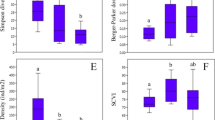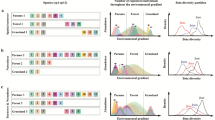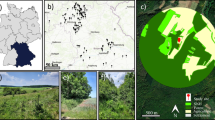Abstract
The creation of Protected Areas was one of the first measures taken for the protection of biodiversity and it is still the most widely used. The establishment of systems to evaluate the effectiveness of the management of these areas are crucial to validate their importance for conservation and guide the managers towards their conservation goals. Aculeate Hymenoptera, specifically Apiformes and Spheciformes, gather exceptional characteristics as bioindicators and are essential to ecosystem sustainability by including key pollinators (Apiformes), contribute for the maintenance of the equilibrium between arthropod populations (Spheciformes), and also reflect the patterns of other taxa. Apiformes and Spheciformes communities were sampled with Malaise traps in eight different habitats initially identified by habitat type (mainly vegetation). These communities were evaluated to determine if the habitats could be differentiated based on their Apiformes and Spheciformes generic communities. Apiformes and Spheciformes diversity provided limited differentiation between habitats but was able to differentiate the most disturbed habitat from the most pristine. In general, Apiformes and Spheciformes communities were different among the eight habitats. It was also possible to establish a relation between some genera and a specific habitat type. Several genera of Apiformes and Spheciformes showed a preference for the riparian galery (RLR) and a mixed woodland (COZ), providing a general idea of the ideal conditions for the development of these groups. These results suggest that Apiformes and Spheciformes communities are a suitable management tool for habitat evaluation.


Similar content being viewed by others
References
Abelho M, Graça MAS (1996) Effects of eucalyptus afforestation on leaf litter dynamics and macroinvertebrate community structure of streams in Central Portugal. Hydrobiologia 324:195–204
Alves AM, Pereira JS, Silva JMN (2007) O eucaliptal em Portugal. Impactes ambientais e investigação científica. ISAPress, Lisboa, Portugal
Ashagrie Y, Zech W, Guggenberger G (2005) Transformation of a Podocarpus falcatus dominated natural forest into a monoculture Eucalyptus globulus plantation at Munesa, Ethiopia: soil organic C, N and S dynamics in primary particle and aggregate-size fractions. Agric Ecosyst Environ 106:89–98
Ashmead WH (1894) The habits of the Aculeated Hymenoptera—III. Pshyche 7:59–66
Báldi A (2003) Using higher taxa as surrogates of species richness: a study based on 3700 Coleoptera, Diptera, and Acari species in Central-Hungarian reserves. Basic Appl Ecol 4:589–593
Bale JS (1991) Insects at low temperature: a predictable relationship? Funct Ecol 5:291–298
Balmford A, Jayasuriya AHM, Green MJB (1996) Using higher-taxon richness as a surrogate for species richness: II Local applications. Proc R Soc Lond B Biol Sci 263:1571–1575
Bitsch J, Leclercq J (1993) Hyménoptères Sphecidae d’Europe occidentale, vol 1. Faune de France 79. Fédération Française Des Sociétés De Sciences Naturelles, Paris
Bitsch J, Barbier Y, Gayubo SF, Schmidt K, Ohl M (1997) Hyménoptères Sphecidae d’Europe occidentale, vol 2. Faune de France 82. Fédération Française Des Sociétés De Sciences Naturelles, Paris
Bitsch J, Dollfuss H, Boucek Z, Schmidt K, Schmidt-Egger C, Gayubo SF, Antropov AV, Barbier Y (2001) Hyménoptères Sphecidae d’Europe occidentale, vol 3. Faune de France 86. Fédération Française Des Sociétés De Sciences Naturelles, Paris
Buchmann SL, Nabhan GP (1996) The pollination crisis—the plight of the honey bee and the decline of other pollinators imperils future harvests. Sciences 36:22–27
Büchs W (2003) Biodiversity and agri-environmental indicators—general scopes and skills with special reference to the habitat level. Agric Ecosyst Environ 98:35–78
Carré G, Roche P, Chifflet R, Morison N, Bommarco R, Harrison-Cripps J, Krewenka K, Potts SG, Roberts SPM, Rodet G, Settele J, Steffan-Dewenter I, Szentgyörgyi H, Tscheulin T, Westphal C, Woyciechowski M, Vaissière BE (2009) Landscape context and habitat type as drivers of bee diversity in European annual crops. Agric Ecosyst Environ 133:40–47
CEUC (1992) Council Directive 92/43/EEC of 21 May 1992 on the conservation of natural habitats and of wild fauna and flora. In: T. C. O. T. E. U. Communities (ed) OJ L 206, 22.7.1992, p 7
Chape S, Harrison J, Spalding M, Lysenko I (2005) Measuring the extent and effectiveness of protected areas as an indicator for meeting global biodiversity targets. Phil Trans R Soc B Biol Sci 360:443–455
Corbet SA, Backhouse M (1975) Aphid-hunting wasps: a field study of Passaloecus. Trans R Entomol Soc Lond 127:11–30
Dias BS, Raw A, Imperatri-Fonseca VL (1999) International pollinators initiative: the Sao Paulo declaration on pollinators. Report on the recommendations of the workshop on the conservation asnd sustainable use of pollinators in agriculture with emphasis on bees. Brazilian Ministry of the Environment (MMA), Brazil
Diniz MA (1962) Claves para la identificación de los géneros de ápidos de la Península Ibérica (Hymenoptera). Graellsia 19:113–135
Doerr SH, Shakesby RA, Walsh RPD (1998) Spatial variability of soil hydrophobicity in fire-prone eucalyptus and pine forests, Portugal. Soil Sci 163:313–324
Donovan B (2003) Potential manageable exploitation of social wasps, Vespula spp (Hymenoptera: Vespidae), as generalist predators of insect pests. Int J Pest Manag 49:281–285
Duelli P, Obrist MK (2003) Biodiversity indicators: the choice of values and measures. Agric Ecosyst Environ 98:87–98
Eickwort GC, Kukuk PF, Wesley FR (1986) The nesting biology of Dufourea novaeangliae (Hymenoptera: Halictidae) and the systematic position of the Dufoureinae based on behavior and development. J Kansas Entomol Soc 59:103–120
Ellison LE, van III Riper C (1998) A comparison of small-mammal communities in a desert riparian floodplain. J Mammal 79:972–985
Fabião A, Madeira M, Cortez N, Magalhães MC, Ribeiro C (2007) As plantações de eucalipto e o solo. In: Alves AM, Pereira JS, Silva JMN (eds) O eucaliptal em Portugal: impactes ambientais e investigação cientifíca. ISAPress, Lisbon, Portugal, pp 137–174
Fiedler K, Schulze CH (2009) Forest modification affects Diversity (but not dynamics) of speciose tropical pyraloid moth communities. Biotropica 36:615–627
Finnamore AT, Winchester NN, Behan-Pelletier VM (1998) Protocols for measuring biodiversity: arthropod monitoring in terrestrial ecosystems. http://www.eman-rese.ca/eman/ecotools/protocols/terrestrial/arthropods/intro1.html
Gaston KJ, Williams PH (1993) Mapping the world’s species—the higher taxon approach. Biodivers Lett 1:2–8
Gayubo SF, González JA, Torres F (2000) Estudio de una comunidad de esfécidos en la zona natural de “Las Arribes del Duero” (Salamanca, Oeste español) (Hymenoptera: Sphecidae). Fragm Entomol 32:181–209
Gayubo SF, González JA, Asís J, Tormos F (2005) Conservation of European environments: the Spheciformes wasps as biodiversity indicators (Hymenoptera: Apoidea: Ampulicidae, Sphecidae and Cabronidae). J Nat Hist 39:2705–2714
Genaro JA (1996) Key to the genus Megachile, Chalicodoma group (Hymenoptera: Megachilidae) in Cuba. Rev Biol Trop 44:193–198
Godinho C, Rabaça J, Segurado P (2009) Breeding bird assemblages in riparian galleries of the Guadiana River basin (Portugal): the effect of spatial structure and habitat variables. Ecol Res 1–12
Gregory S, Wright I (2005) Creation of patches of bare ground to enhance the habitat of ground-nesting bees and wasps at Shotover Hill, Oxfordshire, England. Conserv Evid 2:139–141
Hill JK, Hamer KC (2004) Determining impacts of habitat modification on diversity of tropical forest fauna: the importance of spatial scale. J Appl Ecol 41:744–754
Hirsch M, Wolters V (2003) Response of Aculeate Hymenoptera to spatial features of an agricultural landscape. J Nat Conserv 11:179–185
Jago ND (1998) The world-wide magnitude of Orthoptera as pests. J Orthopt Res 7:117–124
Jenkins CN, Joppa L (2009) Expansion of the global terrestrial protected area system. Biol Conserv 142:2166–2174
Kearns CA, Inouye DW, Waser NM (1998) Endangered mutualisms: the conservation of plant-pollinator interactions. Annu Rev Ecol Syst 29:83–112
Kevan PG (1999) Pollinators as bioindicators of the state of the environment: species, activity and diversity. Agric Ecosyst Environ 74:373–393
Kluser S, Peduzzi P (2007) Global pollinator decline: a litterature review. UNEP/GRID-Europe, Geneva, Switzerland
McNeely JA (1994) Protected areas for the 21st century: working to provide benefits to society. Biodivers Conserv 3:390–405
Melo GAR (2000) Comportamento social em vespas da família Sphecidae (Hymenoptera: Apoidea). In: Martins RP, Lewinsohn TM, Barbeitos MS (eds) Ecologia e comportamento de insetos, vol III. Série Oecologia Brasiliensis. PPGE-UFRJ, Rio de Janeiro, Brazil, pp 85–130
Michener CD (2000) The bees of the world. The Johns Hopkins University Press, Baltimore, Maryland
Ottonetti L, Tucci L, Santini G (2006) Recolonization patterns of ants in a rehabilitated lignite mine in central Italy: potential for the use of Mediterranean ants as indicators of restoration processes. Restor Ecol 14:60–66
R Development Core Team (2009) R 2.9.1. A language and environment for statistical computing computer program, version by R Development Core Team, Vienna, Austria
Rodrigues ASL, Andelman SJ, Bakarr MI, Boitani L, Brooks TM, Cowling RM, Fishpool LDC, da Fonseca GAB, Gaston KJ, Hoffmann M, Long JS, Marquet PA, Pilgrim JD, Pressey RL, Schipper J, Sechrest W, Stuart SN, Underhill LG, Waller RW, Watts MEJ, Yan X (2004) Effectiveness of the global protected area network in representing species diversity. Nature 428:640–643
Rozen JG (1965) The biology and immature stages of Melitturga clavicornis (Latreille) and of Sphecodes albilabris (Kirby) and the recognition of the Oxaeidae at the family level (Hymenoptera, Apoidea). Am Mus Novit 2224:1–18
Seaby RM, Henderson PA (2006) Species diversity and richness. Version 4. Pisces Conservation Ltd, Lymington, England
Sheskin DJ (2004) Handbook of parametric and nonparametric statistical procedures, 3rd edn. CRC Press LLC, Boca Raton, FL
Takumi RL (1999) A systematic review of the Ectemnius (Hymenoptera: Sphecidae) of Hawaii. University of California Press, Berkeley
Terzo M, Ortiz-Sánchez FJ (2004) Nuevos datos para las especies de Ceratinini de España y Portugal, con una clave para su identificación (Hymenoptera, Apoidea, Xylocopinae). Graellsia 60:13–26
Tscharntke T, Gathmann A, Steffan-Dewenter I (1998) Bioindication using trap-nesting bees and wasps and their natural enemies: community structure and interactions. J Appl Ecol 35:708–719
Tylianakis J, Veddeler D, Lozada T, Lopez RM, Benitez P, Klein A-M, de Koning GH, Olschewski R, Veldkamp E, Navarrete H, Onore G, Tschamike T (2004) Biodiversity of land-use systems in coastal Ecuador and bioindication using trap-nesting bees, wasps and their natural enemies. Lyonia 6:7–15
UNEP-WCMC (2008) State of the world’s protected areas: an annual review of global conservation progress. UNEP-WCMC, Cambridge
Walker BH (1992) Biodiversity and ecological redundancy. Conserv Biol 6:18–23
Williams NM, Minckley RLM, Silveirs FA (2001) Variation in native bee faunas and its implications for detecting community changes. Conserv Ecol 5:7
Winston ML (1991) The biology of the honey bee. Harvard University Press, USA
Author information
Authors and Affiliations
Corresponding author
Electronic supplementary material
Below is the link to the electronic supplementary material.
Rights and permissions
About this article
Cite this article
Vieira, L.C., Oliveira, N.G. & Gayubo, S.F. On the use of Apiformes and Spheciformes (Insecta: Hymenoptera) populations as a management tool. Biodivers Conserv 20, 519–530 (2011). https://doi.org/10.1007/s10531-010-9962-2
Received:
Accepted:
Published:
Issue Date:
DOI: https://doi.org/10.1007/s10531-010-9962-2




